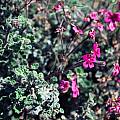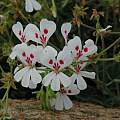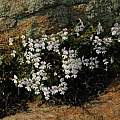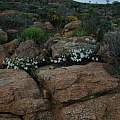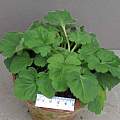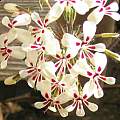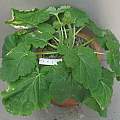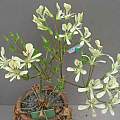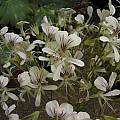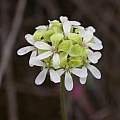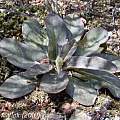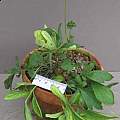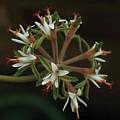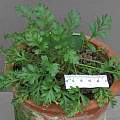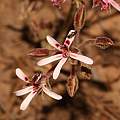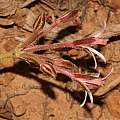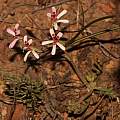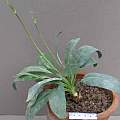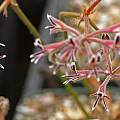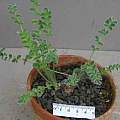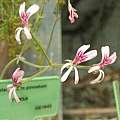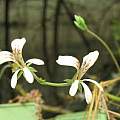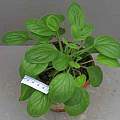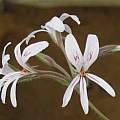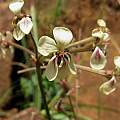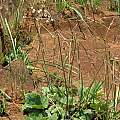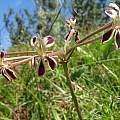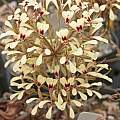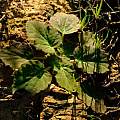Pelargonium species m-p are found on this wiki page
Pelargonium a-c - Pelargonium d-l - Pelargonium q-s - Pelargonium t-z - Pelargonium index
Pelargonium magenteum J.J.A. Van der Walt is a dwarf shrub with tuberous roots found on rocky mountain slopes in fynbos and succulent karoo. It has grey green rounded to kidney-shaped leaves and pink to mauve, but usually magenta flowers with dark spots. This one was blooming in the Cederberg on the way to the Biedouw Valley August 2001. Photo by Mary Sue Ittner.
Pelargonium moniliforme Harv. is a tuberous species from the West Coast of South Africa, from the Southwest corner of the Richtersveld to Karoo Poort in the South and Matjiesfontein in the East. It grows in sand or in clay, on quartzite outcrops and stony areas. It may have cream or yellow coloured flowers, with a wine red blotch in the centre of all five petals. It flowers in September. The name refers to the small tubers that form on its main or lateral roots – however, this is not diagnostic. (Section Hoarea, Incrassatum Group). The first three photos were taken in Namaqualand by Bob Rutemoeller and Mary Sue Ittner. The last two photos from David Victor.
Pelargonium oblongatum E. Mey. ex Harv. is a tuberous plant from Namaqualand and the Richtersveld, from Stinkfontein mountain to the Kamiesberg: a very hot and arid area. It has pale yellow or cream flowers, with feathering on the upper two. The flowers are the largest in this section and have prominent, upcurved stamens, which form a landing pad for its pollinator. It flowers from October to November. The name refers to the sometimes oblong tuber. (Section Hoarea, Punctatum Group). Photos David Victor except for the last which was taken by Bob Rutemoeller at David's in May 2004.
Pelargonium ochloleucum Harv. is a rare tuberous species only known from a few populations in the Little Karoo and the Eastern Cape. Leaves are sparsely hairy and usually dry when the plants are in flower. Flowers are densely arranged in a compact head; the two upper petals are lime green to light yellow and the three lower ones are white. Plants flower in late spring. Photos and text from the book Plants of the Klein Karoo courtesy of Jan and Anne Lise Schutte-Vlok.
Pelargonium parvipetalum E.M. Marais is a tuberous South African plant from the Pakhuis Pass in the South to Gamoep in the North, in various habitats and soil types. The flowers are white with the upper two having dark red feathering. It's one of the earliest flowering plants of this Section, its peak flowering being in September. The petals are very small and insignificant, thus its name. (Section Hoarea, Auritum Group). Photos David Victor.
Pelargonium petroselinifolium G. Don is a tuberous species from the Southwest Cape area of South Africa, around Ceres and on the Koue Bokkeveld plateau. It grows in mountain fynbos or in karroid vegetation. The flowers are pink, the upper two with wine red feathering. Flowering is from October to November. The name means 'Parsley leaved'. (Section Hoarea, Fissifolium Group). The first photo was taken by David Victor. The rest of the photos from iNaturalist were taken by Brian du Preez in November in the Western Cape and shared under a CC BY-SA license.
Pelargonium pilosellifolium (Eckl. & Zeyh.) Steud. is a tuberous plant from the Southern Cape of South Africa, from Keeromsberg to Avontuur, growing in fynbos on sandstone on the shale-sandstone boundaries. The flowers are white, pale pink or pink, with extensive wine red markings in the centres of petals. Flowering is from October to December. The name refers to the hairiness of the leaves (Latin pilosus), which can lead to fungal problems in humid conditions. (Section Hoarea, Proliferum Group). In cultivation the species provides the grower greater opportunity to study the details of its striking flowers. As with other members of the Hoarea section, its blooming occurs after leaves are fully dried. In Southern California this generally occurs in May. With a fast draining mix of grit and sandy soil the species responds well even in wet winters, provided it receives excellent air circulation. Photo #1 by David Victor. Photo #2 by Andrew Wilson.
Pelargonium pinnatum (L.) L'Hér. is a tuberous species from the Southwest Cape of South Africa, from the Cederberg to Albertinia, growing amongst shrubs on all kinds of soils. The flowers vary in colour from white, to cream, yellow, various pinks and purple, with wine red feathering on the upper two. Flowering takes place between November and January. The name pinnatum refers to the pinnate leaves. (Section Hoarea, Pinnatum Group). Photos David Victor.
Pelargonium proliferum (Burm.f.) Steud. is a tuberous plant from the Southwest Cape area of South Africa, from Nieuwoudtville to Bredasdorp. It grows in fynbos on sandstone and in renosterveld on shale. The flowers may be white, cream, pink, with wine red feathering on the top two. Flowering takes place between October and December. The name refers to the fact that the branching scape produces several peduncles, each with many-flowered pseudo-umbellets. (Section Hoarea, Proliferum Group). Photos David Victor.
Pelargonium pulverulentum Colvill ex Sweet is a geophytic species with a large woody tuber endemic to the Eastern Cape and KwaZulu-Natal where it grows in grassland. It has hairless heart shaped leaves that are shallowly lobed to deeply indented and dull yellow flowers. The top two are reflexed, unmarked or streaked purple black and the lower three yellow, blotched purple black. It flowers September to February. Photos taken in Maclear and Waainek by Cameron McMaster.
Pelargonium punctatum (Andrews) Willd. is a tuberous species from the southern portions of Namaqualand and in the western Karoo around Calvinia and the Botterkloof Pass. In the latter area it is usually found growing below karroid shrub, protected from animals. Near Clanwilliam it occurs on ridges and exposed to full sun. During winter (June-July) it withstands significant frosts without damage. The flower petals are pale yellow to buff, with deep red dots on the two upper ones. The species name means dotted, in reference to the dotted petals. It blooms from October to early November. (Section Hoarea). It has proven to be an outstanding performer in cultivation, blooming (in southern California) in May with multiple umbels, each with twenty flowers or more. Photo by Andrew Wilson. The second photo from iNaturalist was taken by Nick Helme in July in the Northwest Cape and shared under a CC BY-SA license.
Pelargonium a-c - Pelargonium d-l - Pelargonium q-s - Pelargonium t-z - Pelargonium index
